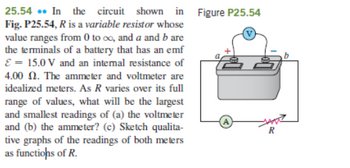Question

Transcribed Image Text:25.54. In the circuit shown in
Fig. P25.54, R is a variable resistor whose
value ranges from 0 to co, and a and b are
the terminals of a battery that has an emf
E = 15.0V and an internal resistance of
4.00 2. The ammeter and voltmeter are
idealized meters. As R varies over its full
range of values, what will be the largest
and smallest readings of (a) the voltmeter
and (b) the ammeter? (c) Sketch qualita-
tive graphs of the readings of both meters
as functions of R.
Figure P25.54
R
Expert Solution
This question has been solved!
Explore an expertly crafted, step-by-step solution for a thorough understanding of key concepts.
This is a popular solution
Trending nowThis is a popular solution!
Step by stepSolved in 3 steps with 1 images

Knowledge Booster
Similar questions
- Four resistors are connected to a battery as shown in the R, = 2R figure. The current through the battery is I, the battery's electromotive force (emf) is E = 6.10 V, and the resistor values are R1 = R, R, = 2R, R3 = 4R, and R4 = 3R. Find R, = R the voltages across each resistor. R = 3R V = V V½ = R, = 4R V3 = V V4 = Varrow_forwardει R1 a R1 w R2 R1 www R1 As shown in the figure, the resistances are R1 = 3.0 2 and R2 = 6.0 2, and the ideal batteries have emfs E₁ = 5.0 V, and E2 = E3 = 10.0 V. What is the size and direction of the current in battery 1 (ta positive current as that flowing through the battery from - to +)? Submit Answer Tries 0/10 What is the size and direction of the current in battery 2 (take positive current as that flowing through the battery from to +)? Submit Answer Tries 0/10 What is the size and direction of the current in battery 3 (take positive current as that flowing through the battery from - to +)? Submit Answer Tries 0/10 What is the potential difference Va - Vb? Submit Answer Tries 0/10arrow_forwardA 10 μF capacitor with an initial energy of 0.1 J is discharged through a 7.5 MΩ resistor. What is the initial charge on the capacitor? The charge, Q0 = Units . What is the current through the resistor when the discharge starts? The current, I0 = Units . Determine the potential difference across the capacitor and the rate at which the thermal energy is dissipating in the resistance 0.9 min after the discharge starts. The potential difference across C, VC = Units . The power dissipated in R, P = Units .arrow_forward
- The capacitance of a parallel-plate capacitor is proportional to the area of its plates and inversely proportional to the plate separation. O True O False The drift speed of electrons in a copper wire carrying 10 A current is much greater than 1 m/sec. O True O False The electric power dissipated in a resistor is eventually converted to kinetic energy of charges. O True O Falsearrow_forwardnone of the preceding DETAILS SHIPPS15 8.2.E.020. Two resistors with values of 29 0 and 45 0, respectively, are connected in parallel and hooked to a 18 V batte (a) What would be the current in the circuit? A (b) What would be the power expended in the circuit? W DETAILS SHIPPS15 8.2.E.018. A 13.0 W LED light bulb is turned on. It has an operating voltage of 120 V. (a) How much current (in A) flows through the bulh?arrow_forwardFind (a) the equivalent resistance of the circuit in Figure P28.60, (b) the potential difference across each resistor, (c) each current indicated in Figure P28.60, and (d) the power delivered to each resistor.arrow_forward
- The brightness of a lightbulb is dependent on the current that goes through the lightbulb (in reality on the power, which is I^2/R). In Europe, the voltage used is 220 Volts, as opposed to the 120 Volts used in the USA. Will a lighbulb that is made for European voltage work well or poorly in the USA? It will work poorly in the USA. Since I=V/R, if V decreases, so does I, and so does the brightness. It will work more efficiently in the USA. Since I=V/R, if V decreases, I increases, and the brightness increases. It will work better in the USA because the resistance of the wires is smaller. Whether it works better or worse depends on how modern the wiring system is, regardless of the voltage, V.arrow_forwardIn the circuit shown in Figure OQ28.12, each battery is delivering energy to the circuit by electrical transmission. All the resistors have equal resistance. (i) Rank the electric potentials at points a, b. c, d, and e from highest to lowest, noting any cases of equality in the ranking. (ii) Rank the magnitudes of the currents at the same points from greatest to least, noting any cases of equality.arrow_forward
arrow_back_ios
arrow_forward_ios